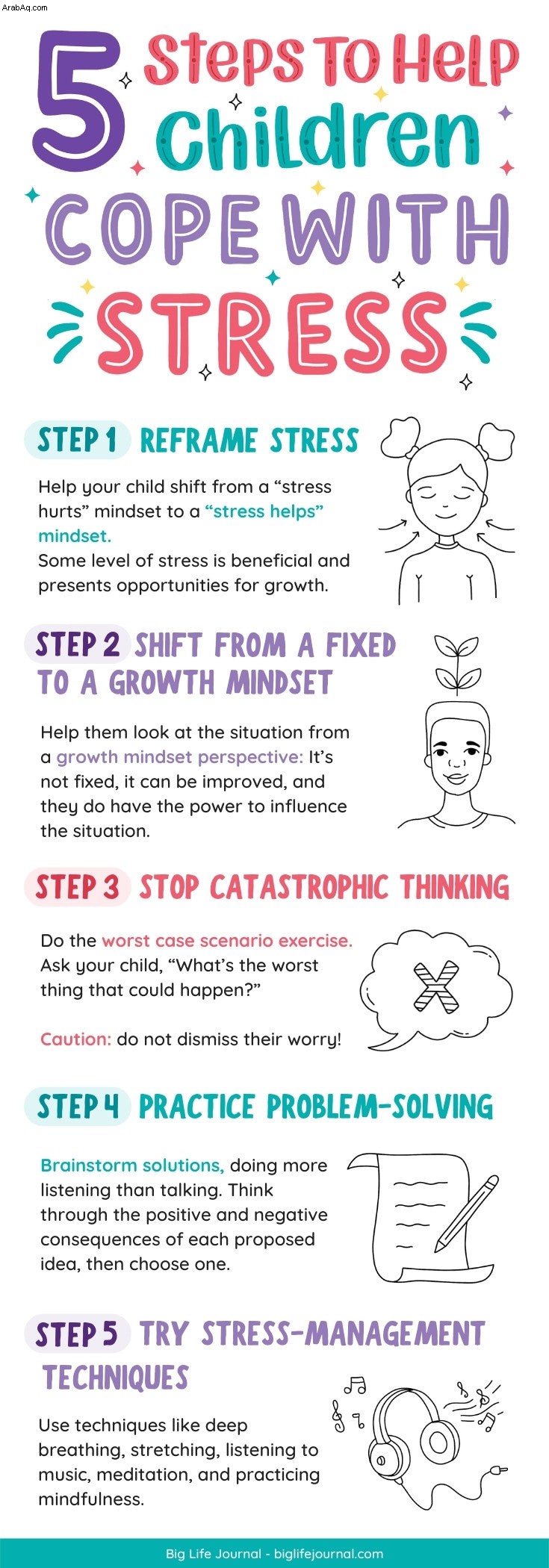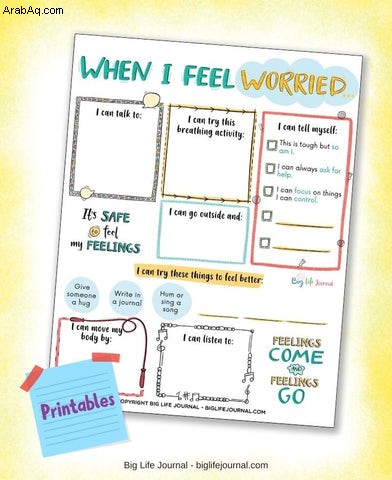تظهر الدراسات أن الأطفال والمراهقين يعانون من ضغوط اليوم أكثر من أي وقت مضى. أدت الضغوط مجتمعة من العمل المدرسي ، والامتحانات عالية المخاطر ، والحياة الاجتماعية ، والرياضة ، أو الأنشطة الأخرى ، بالإضافة إلى الكثير من وقت الشاشة ، إلى مستويات أعلى بكثير من القلق والتوتر بين الشباب.
لا يمكننا القضاء تمامًا على التوتر الذي يعاني منه أطفالنا. بالإضافة إلى ذلك ، فإن حماية طفلك من صعوبات الحياة لن تقدم له أي خدمة. من الأفضل بكثير تربية طفل مرن يمكنه التعافي من المصاعب والتحديات.
نظرًا لأن التوتر جزء طبيعي من الحياة ، فإن هدفك هو تعليم طفلك إستراتيجيات صحية من أجل التأقلم مع الإجهاد. يمكنك البدء باتباع الخطوات الخمس أدناه.
قبل المتابعة ، اعتقدنا أنك قد ترغب في تنزيل الملصق المجاني عندما أشعر بالقلق . استخدم هذه المطبوعة الشهيرة لوضع خطة مع طفلك عندما يظهر قلقهم. سيكون لدى طفلك قائمة بإستراتيجيات التأقلم الخاصة به لتهدئة قلقه وقلقه

قبل أن تبدأ في مساعدة طفلك على التعامل مع التوتر ، تأكد من أن ما يشعر بالتوتر في نطاق دائرة التحكم .
الخطوة 1:إعادة تأطير الضغط
ساعد طفلك على التحول من عقلية "التوتر يؤذي" إلى عقلية "التوتر يساعد" . يمكن أن يكون الإجهاد دافعًا للنمو إذا فهم الأطفال أن المواقف العصيبة لن تستمر إلى الأبد. بدلاً من ذلك ، تمثل هذه المواقف تحديات يجب التغلب عليها ودروسًا للتعلم.
يقارن عالم الأعصاب الإدراكي والمؤلف إيان روبرتسون نظام الاستجابة للتوتر بجهاز المناعة: يصبح أقوى مع الممارسة.
بعد استجابة قوية للضغط ، الدماغ يعيد توصيل نفسه للتذكر والتعلم من التجربة. هذه هي الطريقة التي يجهزك بها الدماغ للتعامل مع المواقف العصيبة المماثلة في المرة القادمة.
يتسبب الإجهاد في إفراز الدماغ لمادة كيميائية تسمى النورادرينالين. لا يمكن للدماغ أن يعمل بأفضل حالاته مع الكثير من النورأدرينالين. لكن خمن ماذا؟ صغير جدا النورادرينالين ليس جيدًا أيضًا.
ضغط منخفض بشكل معقول يمكن للمستويات أن تبني في الواقع وظائف دماغية أقوى ، مما يجعل البشر أكثر ذكاءً وسعادة ، وفقًا لروبرتسون.
مسلحًا بالمعلومات الواردة أعلاه ، فأنت على استعداد لمساعدة طفلك على إعادة صياغة التوتر. اتبع الخطوات أدناه للبدء:
1) اعتماد يساعد الضغط النفسي على التفكير بنفسك اقبل أنه لا يمكنك منع التأكيد ، أن بعض التوتر مفيد بالفعل ، وأن التوتر يمكن أن يكون فرصة للنمو. إذا لم تكن لديك هذه العقلية ، فسيكون من المستحيل تقريبًا تعليمها لطفلك. (بالإضافة إلى ذلك ، يعد تقليل التوتر أمرًا حيويًا - يمكن أن يكون التوتر "معديًا". عندما يشعر طفلك بالتوتر ، فإنه في الواقع يغير من فسيولوجيته لينتقل تلقائيًا إلى وضع التوتر أيضًا.)
2) افهم الأسباب الكامنة وراء ضغوط طفلك ، بدلا من رفضها. بالنسبة للبالغين ، قد تبدو مشاكل الطفل تافهة. لكنها تبدو كبيرة بالنسبة للطفل ، وتسبب له ضغوطًا أو انزعاجًا حقيقيًا.
3) ساعد طفلك على إعادة صياغة التوتر by discussing the following:
- Stress is a natural part of life.
- Stress comes and goes.
- Stressful situations can be beneficial if you learn from them, take action, and seek solutions. Provide examples from your own experiences.
4) Guide your child to find areas of growth or lessons that can come from their latest challenge.
- Ask your child to think of previous stressful situations. What did they learn from those experiences?
- What strengths did they use to handle these situations?
- What strengths can they use now?
Once stress is viewed as an opportunity for growth , your child will develop a much healthier relationship with stress and find it easier to manage.
Step 2:Shift from a Fixed Mindset to a Growth Mindset
Reframing stress means your child will need to switch from a fixed mindset to a growth mindset. Studies show even brief growth mindset training significantly reduces stress and improves grades among teens.
In stressful situations, we often feel overwhelmed and are more likely to fall into a fixed mindset thought process; there’s nothing much we can do to change the situation, our abilities are limited to what we can do, and we might as well stop trying.
For example, if your child is stressed about exams, they might think, “It doesn’t matter how much I study. I’ll never be able to pass these tests. It’s hopeless.”
Help your child look at the situation from a growth mindset perspective - it’s not fixed, it can be improved, and they do have the power to influence the situation.
If you hear your child say a fixed mindset statement like, “I can’t do this,” or, “I’m just not good at math,” help them find a growth mindset alternative.
Encourage your child to practice growth mindset affirmations, and remind them that putting forth effort and trying different solutions will help them solve the problem and reduce their stress.
Of course, a mindset shift doesn’t happen overnight. Throughout this process, focus on and celebrate incremental improvement .
For more tips on teaching growth mindset, visit our 4-week guide for teaching growth mindset to children.
Step 3:Stop Catastrophic Thinking
Often, children and teenagers (and sometimes adults) respond to stress with catastrophic thinking. “If I fail this test, my whole life is ruined!” or, “Sarah isn't being nice to me. No one will ever like me!”
When this occurs, start by validating your child’s emotions so they feel listened to and understood. “I understand you’re feeling nervous about your algebra test.”
Next, use the “worst-case scenario exercise.” Ask your child, “What’s the worst thing that could happen?” If your child really does fail the test, or if Sarah keeps being unkind, what’s the absolute worst thing that could happen?
You can also ask your child how likely it is this scenario will happen, or if any other scenarios are MORE likely to occur. Conclude by asking, “What would you do if it did happen?” and help your child brainstorm if they struggle to come up with a solution.
Coming up with a potential solution will help your child feel more in control of their stress. Once they have a plan for the worst-case scenario, they’ll also spend much less time worrying.
The purpose of this exercise is NOT to dismiss your child’s fears but to help your child realize the “worst thing” is probably not as catastrophic as they initially imagined.
Don't forget to download our FREE When I Feel Worried Poster so your child has a list of their own coping strategies to calm anxiety and worry.

Step 4:Practice Problem-Solving
Once your child has reframed stress and adopted a growth mindset, they need to learn how to put these ideas into practice by problem-solving. This will likely take many examples, modeling, and real-life experience before it truly takes root.
You can find a variety of developmentally appropriate activities and strategies for teaching problem-solving here. A good starting point is to teach your child the following three-step process:
- Step One:Naming and Validating Emotions. Ask your child to name how they're feeling—overwhelmed, worried, anxious—and then repeat it back to them. “I understand you’re worried you won’t do well on your exam.”
- Step Two:Processing Emotions. Guide your child to their calming space. If they don't have one, it's a good idea to create it (we recommend the Time-In Toolkit by Generation Mindful). Let them calm their body and process their emotions so they're ready to problem solve, learn, and grow. You may have older children take deep breaths or practice some growth mindset affirmations. “I can do well on this test if I try.”
- Step Three:Problem Solving! Brainstorm solutions with your child, doing more listening than talking during the conversation. For instance, your child may come up with solutions such as studying with a friend who’s doing well in the class, asking the teacher for extra help, or devoting a certain amount of time to studying each day.
Once you’ve brainstormed solutions, help your child think through the positive and negative consequences of each proposed idea and then choose one. Your child may need prompting but aim to contribute only open-ended questions to the conversation, allowing your child to do most of the problem-solving themselves.
If the initial plan (let’s call it Plan A) doesn’t work, your child will have numerous backup plans ready and waiting. Knowing this will make their problem much less stressful. And once they master the art of problem-solving, they’ll have the tools they need to tackle stressful situations on their own.
Step 5:Use Stress-Management Techniques
The techniques listed above will work best when your child is in a calm state of mind that’s conducive to thinking critically and logically. You can help your child achieve this calm state using stress-management techniques.
There are many strategies for managing stress, so consider trying a few of the techniques listed below to determine what works for your child:
- Deep breathing: Breathe in deeply, hold the breath for a moment, then slowly release it. Repeat the process until your child feels calmer.
- Progressive muscle relaxation :Pretend you’re squeezing a lemon, then drop the lemon and relax. Pretend you’re pushing your toes deep into a mud puddle, then step out of the mud puddle and relax your feet.
- Stretching: This helps release built-up tension in muscles.
- Listening to music
- Playing, exercising, or heading out into nature
- Using brain breaks when facing a difficult academic challenge
- Laughing: Laughter can be a good stress reliever. Make silly faces or tell jokes to calm your child before discussing the problem.
- “ 5-4-3-2-1” Technique : Identify five things you can currently see, four you can hear, three you can feel, two you can smell, and one you can taste.
- Meditation : It can be as simple as having your child close their eyes and breathe in and out. Tell your child to count each breath (a breath in and a breath out makes one single count), focusing on the sound of their breath. When they reach a minimum count (50, for example), your child can take a deep breath, release it slowly, and open their eyes.
Remember these techniques are not intended to eliminate ضغط عصبى. Rather, they help your child reach a calm state of mind so they can address the source of their stress and solve the problem.
When we view all stress as negative and unhealthy and attempt to eliminate it, we ultimately create more stress, for both ourselves and our children.
Instead, it’s best to teach our children that stress is a natural part of life that can be managed effectively.
Start by helping your child reframe stress, shifting from a fixed mindset, and the idea “stress hurts” to a growth mindset and the belief “stress helps.”
Help your child learn to recognize and stop catastrophic thinking, and teach them how to identify the stressor (main problem) and then brainstorm solutions. You can also try stress-management techniques to help your child reach a calm state of mind.
Your child can’t control how stressful situations unfold, but they can control how they respond to them. Instead of going into meltdown mode, they’ll go into problem-solving mode, allowing them to conquer the challenge and learn valuable lessons along the way.
Looking for additional resources to support building grit and resilience in your child? The Build Your Frustration Tolerance Masterclass is a self-paced growth mindset parenting masterclass where you'll learn how to help your child push ahead and persevere instead of quitting or giving up at the slightest setback. You'll get lifetime access so you can go through all the materials at your own pace. Our expert parenting educators will give you specific tools and strategies to raise a child who has the CONFIDENCE AND DETERMINATION to overcome their frustration and persevere.






